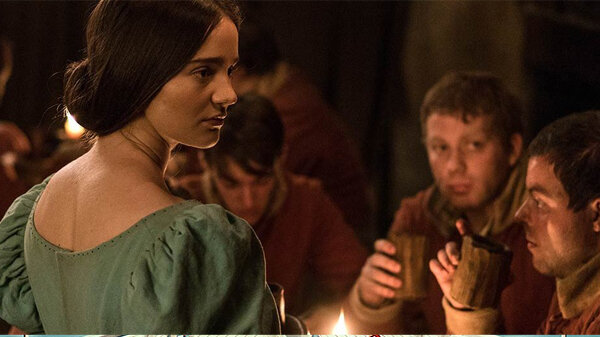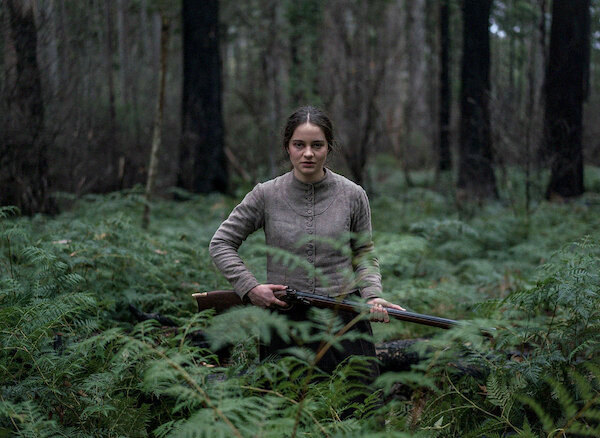The template of abuse against female victims has long populated the genre of horror films, but now, three women directors release films to change the story and readjust what matters. Mary Beth McAndrews delves into the nuances of The Nightingale, M.F.A. and Holiday.
Horror is a genre that relies on spectacle to titillate and terrify viewers. Blood and other bodily fluids ooze from orifices and gaping wounds, rendering the human body into a mess of ruined flesh. While gore and excessive kills are two key devices in the genre, rape is another popular trope used by predominantly male directors to shock audiences. In the often exploitative subgenre of rape-revenge films, female protagonists are stripped naked and shown screaming in the dirt, as multiple men laugh as they take turns raping her. This is somehow all justified when she gets her eventual revenge on her assaulters, and transforms into a powerful creature. But, why is rape the way to justify female anger, and the sole source of a woman’s strength? It is not just another cinematic trope to dip into when writing a script, but a horrifying reality that many women have experienced. Recently female directors Jennifer Kent, Natalia Leite, and Isabel Eklof have tackled the subject in their films, to portray it with more nuance and reality. They are working against the idea of rape as spectacle, instead framing it as something very real that isn’t so easily avenged.
In Kent’s The Nightingale, Leite’s M.F.A., and Eklof’s Holiday, each director examines how the act of rape is a tool of control wielded by the men in each female character’s life. In examining how women are manipulated and abused through sex, these films address the relationship victims have with perpetrators and the lasting effects such acts of violence have on survivors. Importantly, all three films include the revenge aspect of the rape-revenge film as each female character resorts to murder to achieve what they perceive is justice; if no one else is going to do anything about it, why not them? While moments of violence are briefly satisfying, they have consequences, be it through arrests or an empty feeling that they thought an act of vengeance could fix. This leaves the viewer with a sense of nihilism – if these women can’t achieve justice for themselves, what hope is there that any rape survivor can? This nihilistic approach to rape and revenge lends itself to what many rape survivors experience, as law enforcement can do little to nothing to bring perpetrators to justice.
According to the 2010-2106 National Crime Victimization Survey, 8 out of 10 rapes are committed by someone the survivor knows. Within that statistic, 33% of rapes are committed by a romantic partner and 39% are committed by an acquaintance. All three aforementioned films reflect this harrowing reality, as each sexual assault is performed by someone known to the victim. In The Nightingale, Clare (Aisling Franciosi) is repeatedly raped by her employer Hawkins (Sam Claflin). In M.F.A., Noelle (Francesca Eastwood) is taken advantage of by a classmate and her crush. In Holiday, Sascha (Victoria Carmen Stone) is repeatedly raped by her much older boyfriend when she is too intoxicated to consent. While these scenes are deeply upsetting, they are shot through a careful lens that eschews the typically invasive male gaze seen in films such as I Spit On Your Grave and Ms. 45. Instead of reveling in images of the naked female body in pain, Kent, Leite, and Eklof either rely on facial close-ups or detached long shots to create these moments.
Jennifer Kent’s 2019 film The Nightingale has already garnered a reputation for its brutality, particularly in its representations of rape. Sexual assault is shown on three occasions to underscore British colonial brutality in 1825 Tasmania, when it was a penal colony. Two of these assaults force Clare to embark on a bloody mission of revenge to kill those who murdered her family. Kent has said in interviews that she does not consider her second feature to be a rape-revenge film, but there is no denying what it shares with the subgenre as Clare traipses through dense forest searching for the man who ruined her life.
The first act of The Nightingale features two scenes where Clare is raped by Hawkins, as an exercise in control over her. He is her master and no matter how much she protests, he will get what he wants. He refuses to give her freedom based on how much he desires her body. The first case of assault happens in his quarters. As the act begins, the camera cuts to Clare’s face, which morphs from anguish to pain to a blank expression that connotes dissociation. She disconnects from reality to cope with the situation at hand, one she has lived through countless times. In focusing on her facial expressions, rather than the entire frame, Kent makes the moment solely about Clare; she does not grant the audience access to the spectacle of assault. The second time Clare is raped, the camera shows more of the violence that unfolds around her as her husband and daughter are killed. While this scene leans more heavily into extreme violence, Clare’s body is still not objectified — instead, the focus is on colonial violence against the Irish.
The final rape scene does not involve Clare, but an indigenous woman, Lowanna (Magnolia Maymuru) who is captured by Hawkins and his small band of soldiers. While it’s a case of rape happening to a woman by strangers, the way the scene is handled follows Kent’s careful use of the camera as it hones in on her face, just as it focused on Clare’s. They share a similar sequence of emotions as Lowanna goes from anguish to dissociation, waiting for the experience to be over. This scene presents the sole moment of female nudity in the film, but only because it is an element of Lowanna’s tribe’s garb. Throughout The Nightingale, despite the colonial hierarchy created between white people and Tasmania’s indigenous population, the women are united in their suffering at the hands of the white men in power. Their unity is shown particularly in the way they both deal with sexual violence through mechanisms of self-defense where they force themselves to disengage with reality.
Leite handles the sexual assault scene in M.F.A. using a similar gaze that places emphasis on the survivor’s face rather than the spectacle of her rape. It begins with art student Noelle deciding to blow off some steam at a party hosted by a male classmate she has a crush on. She shows up and timidly begins to flirt with him, to which he responds with an invitation to his room. She follows him, and as soon as he shuts the door, he becomes sexually aggressive. Noelle repeatedly says no and attempts to push him off. He responds to her refusal by shoving her onto his bed, holding her down, and raping her. Rather than using the scene to emphasize her pain and eventual numbness during the act, Noelle’s face is the camera’s focal point. This was a person she was attracted to and trusted, only to be betrayed by his sexual appetite. To him, this was a consensual hook-up that lasted mere minutes. To Noelle, this is a trauma that cannot be erased with a half-hearted apology.
These moments of detachment in both The Nightingale and M.F.A. serve as foils to previous representations of rape in the rape-revenge genre. In I Spit On Your Grave, the female protagonist's rape is shot to focus on the rapists’ perspectives and experiences rather on the woman’s psychological state. The naked female body is put on display, little more than a set of breasts to ogle at despite her pain. Kent and Leite opt to ignore the men in their rape scenes almost completely; they instead want the viewer to identify and understand the anguish of Clare and Noelle, rather than revel in male pleasure.
Unlike The Nightingale and M.F.A., Holiday opts to view its rape scene in a wide shot rather than lingering on Sascha in close-up. She is on vacation with her wealthy, much older, crime boss boyfriend and is meant to be the hot sidepiece who is willing to have sex whenever it is demanded of her. He often drugs her so he can manipulate her limp, unconscious body like a sex doll. While in many films women are shown being drugged by a nameless stranger, Holiday depicts a woman drugged and raped by her boyfriend. Sascha is dehumanised; merely a plaything for him, to provide entertainment whenever he demands it. While Sascha’s face is not shown to the audience during her rape, the scene is viewed from a distance. This makes the scene not about spectacle, but about how cold the entire situation is. The room is stark, the floors are a chilling white, everything feels sterile. This is not the forest floor of I Spit On Your Grave or the dirty streets of Ms. 45; nor is it meant to be a gritty scene portraying the horrors of backwoods rednecks or men in the city. It is a sober and unsettling moment in which an unconscious Sascha is violated by her boyfriend, the person she loves, or at least appears to love.
However, she is shown still disengaging from reality as she ponders her relationship and how she got here in the first place. As Sascha absentmindedly dances to pulsating club music, she stares at herself in a mirror. She looks at her reflection and as she sways, she pets the image as if she’s trying to remember who she actually is. Regret, fear, and resignation all flicker across her face as she reluctantly returns to her boyfriend; she is unable to leave him due to his violent threats and warnings about leaving him. This is Holiday’s strongest portrayal of post-traumatic stress disorder.
M.F.A. and The Nightingale delve into the effects of PTSD on their female characters, which once again push against typical portrayals of women in rape-revenge films. Clare and Noelle do not immediately turn to violence, but rather suffer from psychological side effects that sit and fester like putrid wounds, oozing into the physical world when they least expect it. As she heals, Noelle believes she is ready to have sex again after the assault, and begins kissing her friend. As they continue to kiss, she has a flashback and immediately recoils, crying and screaming for her friend to leave. PTSD flashbacks tend to strike unexpectedly, prompted by and destroying intimate moments, that in other circumstances would be positive and pleasurable. It’s an ugly, difficult, and painful thing. Kent stresses this in The Nightingale as Clare dreams and hallucinates about her rapist and her dead family. She wakes up screaming, her flashbacks and hallucinations felt so strongly in her body that they throw her down a hill. Her traumas haunt her every step and no matter how hard she tries to fight back, she cannot escape them.
But PTSD doesn’t just manifest through flashbacks and nightmares. It can have more tangible, physical side effects, as well. In the days after her rape, Noelle appears feverish: her face is pale, her eyes look dull, and she is curled up in bed. The stress of her trauma has more obvious symptoms that connote an illness, something that has weakened her immune system. This is a common occurrence with PTSD, as not many realize the physical toll trauma can have on the body. In The Nightingale, Clare’s own PTSD wears on her and exhaustion begins to affect her ability to do even the simplest tasks. Trauma weighs heavy on the mind, and can render survivors utterly exhausted and ill from trying to cope with that weight. While Noelle and Clare struggle to appear fine after their rapes, their bodies begin to crumble.
While The Nightingale, M.F.A., and Holiday are not the only existing female-directed rape-revenge films, they are the three contemporary depictions that try to grapple with the realities and side effects of sexual assault. They demonstrate how rape can be depicted on screen in non-exploitative and effective ways. Instead of utilising it as a device to shock and disgust spectators, it features in these films to confront just how often women are raped, and how often the perpetrator is someone close to the survivor. Rape is not a one-time event that occurs and then transforms a woman into a powerful avenger. Instead, it haunts survivors, lurks in their minds, and causes immeasurable bouts of fear. These films addresses that persistent fear, to show that rape is not a catalyst for violent entertainment, but a heinous act that should not be taken lightly or portrayed flippantly. Kent, Leite and Eklof create women who were always strong and must mine that strength in order to survive beyond trauma. Their work takes a questionable genre and rebuilds it as a site for female empowerment, a place where women’s stories are told without indulging male fantasy.
Mary Beth McAndrews (@mbmcandrews) is freelance writer based in Chicago. She loves all things macabre, and mostly writes about the intersection of horror and gender. She is an editor for Much Ado About Cinema and contributor for Nightmare on Film Street.
READ ME is a platform for female-led writing on film commissioned by Girls on Tops. Louisa Maycock (@louisamaycock) is Commissioning Editor and Ella Kemp (@ella_kemp) is Contributing Editor.





